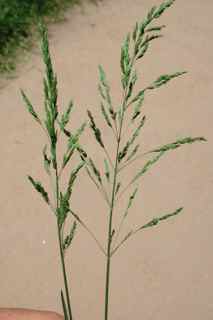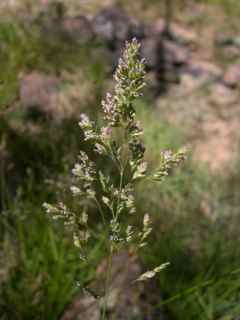|
|
 Seedhead Sedona areaMax Licher @http://swbiodiversity.org, Usage Rights: Creative Commons Attribution-ShareAlike (CC BY-SA) |  Seedhead Foxboro LakeMax Licher @http://swbiodiversity.org, Usage Rights: Creative Commons Attribution-ShareAlike (CC BY-SA) | | | | |
|
| | |
Origin: Introduced Season: Cool and Warm
Habitat Description: Found in moist to dry meadows, open woods, roadsides, and waste places. Naturalized at middle and high elevations in the Southwest.
Plant Communities:Montane Conifer Forest, Riparian, Disturbed Areas
Elevation: 3500 - 11000 feet
Desc:
A low growing sod-grass that spreads from rhizomes. Seedheads pyramidal, erect having numerous slender branches, lowest branches usually five in a whorl. Spikelets multi-flowered.
Identification Notes: Loosely tufted rhizomatous perennial, slender, wiry stems branch at base. Blades folded or flat, canoe-tipped, two obvious veins either side of mid-vein. Seedhead pyramidal; spikelets laterally compressed with 2 to 5 florets. Lemmas hairy-webbed at base.
Grass Type: Perennial mat or sod-forming Rhizomes: Y Stolons: N
Large Dense Clump (> 2 feet): N Bushy (highly branched): N
Height with Seedheads: 24 to 36 inches
Seedhead Structure: Branched - open and spreading Seedhead Droops: N
Flowering Period: Apr - Oct
Number of Flowers per Spikelet: Multi-flowered Spikelets One-sided: N
Awns: Absent Three Awns: N Awns Bent: N
Flower and Seedhead Notes: Pyramid-shaped, 1 to 4 inches long, open. Lowermost branches slender, spreading, usually five in a whorl. Individual florets with copious cobweb-like hairs at base, are somewhat contracted after flowering and purplish.
Blade Hairy:
N
Blade with White Margins:
N
Blade Cross section:
Flat or folded
Blade Notes:
Blades 3/8 to 4 inches long and thin, flat, folded, or rolled involute. Lower surfaces are hairless, top surfaces are smooth or sparsely hairy with two impressed parallel veins.
Sheath Hairy:
Y
Tuft of Hairs at top of Sheath or Collar:
N
Ligules:
Membranous and hairy
Auricles (Ear-like lobes at collar area:
N
Forage Value:
Good early spring forage for livestock and elk, mule deer, and bighorn sheep in early spring and winter when few other plants are growing. Cottontail rabbit and wild turkey consume the leaves and seeds of Kentucky bluegrass.
|
|